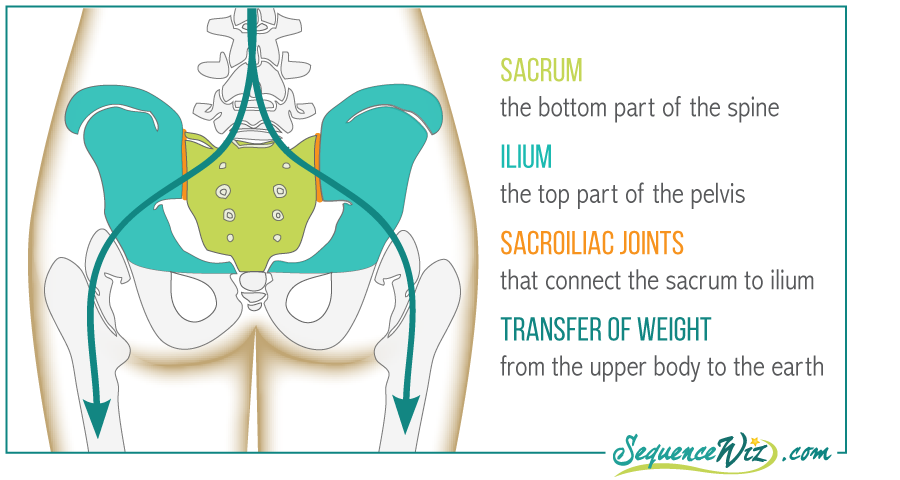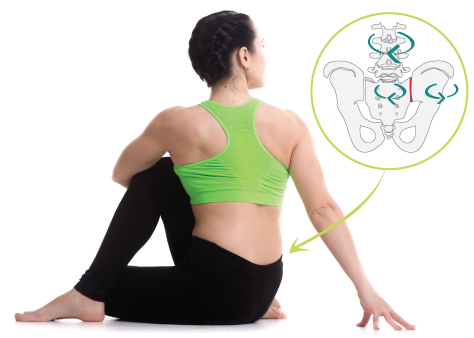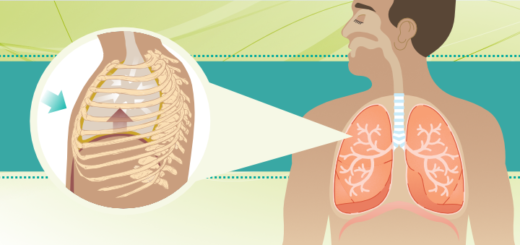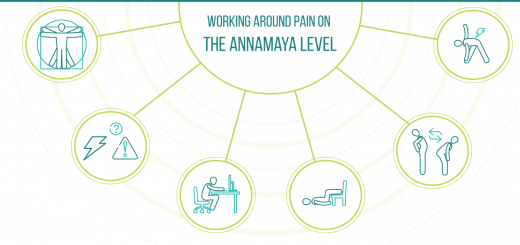How to protect your sacrum during twisting
6Do you know how tsunamis get started? One of the most common reasons is an underwater earthquake that happens because of the shifting of tectonic plates. Those plates enclose the surface of the earth and usually fit together nicely like pieces of a puzzle with very little movement between them. They are held together by constant pressure, and sometimes due to the heat activity in the Earth’s core, they slip in relation to one another.
This causes the earth to shake (earthquake) and generate a wave (beginning of a tsunami).
The relationship between the two sides of your pelvis and the sacrum is similar to the relationship between the tectonic plates. Your sacrum fits nicely between the bones of the pelvis and is connected to it via the sacroiliac joints. The entire structure needs to be stable and symmetrical to properly transfer the weight of the structures above (head, ribcage, spine, organs, muscles, etc.) through the sacrum, into the pelvis and then into the earth.
In some of us, unfortunately, this entire structure is not stable enough because the sacroiliac ligaments are a little loose (from birth, pregnancies, previous injuries, etc.). Loose ligaments have trouble maintaining a proper relationship between the sacrum and pelvis, and the sacrum can “pop out” of place, just like a shift of tectonic plates. As a result you get a tsunami of pain, an overall feeling of instability, asymmetry, etc.
This usually happens as a result of some kind of asymmetrical activity, like putting most of your weight on one foot and then pivoting on it (like you do in golf), or sitting with one hip slightly forward when driving, or doing lots of different yoga poses on one side before you switch to the other (and any other asymmetrical activity you can imagine). Once your SI ligaments become destabilized, it is much easier to irritate them, so it becomes easier for them to pop out of place, unless you strengthen the muscles that surround them (you cannot strengthen your ligaments).
 What happens to your sacrum when you twist? For the twist to happen we need to either fix the position of the pelvis, and then rotate the upper body against it; or move the upper body and the lower body in two opposite directions. To make that happen we usually flex and adduct one leg (folding it in toward the body) and then turn the upper body the other way. For example, we fold the right leg in and turn the upper body to the right (<— like in this image).
What happens to your sacrum when you twist? For the twist to happen we need to either fix the position of the pelvis, and then rotate the upper body against it; or move the upper body and the lower body in two opposite directions. To make that happen we usually flex and adduct one leg (folding it in toward the body) and then turn the upper body the other way. For example, we fold the right leg in and turn the upper body to the right (<— like in this image).
This also means that the right side of the pelvis will pull forward and to the left following the movement of the right leg. But at the same time your spine will be rotating to the right and it will pull the sacrum with it. So now you have the right side of your pelvis and your sacrum rotating in two opposite directions, which puts a strain on the sacroiliac ligaments on the right side. The strain will be even more pronounced if you use arm leverage to deepen the twist. This is just what happens when you twist. Now for most folks who have stable SI ligaments this shouldn’t be a problem (unless, of course, they “muscle their way” into the twist), but for those of us who have wonky SI ligaments, this type of action can create more instability and pain.
That’s why we usually recommend that students stay away from twists altogether when they have an SI joint flare up; and once things begin to settle, use the following guidelines to minimize the risk of the SI strain in twists:
- Limit the number of twists in a practice
- Make sure to balance out and stabilize the sacrum at the beginning and the end of the practice by doing Bhujangasana at the beginning and Vimanasana toward the end.
- Choose twists where the legs are kept parallel to each other or together, rather then one foot folding over the other – this will minimize the pull on the SI ligament.
Now, some people will argue that twisting can actually help pop the sacrum back into place. This can be the case and depends on the type of displacement. After all, twisting does help realign the relationship between the pelvis and the spine. But to be able to do that successfully, you need to be very gentle, very precise and know exactly what you are doing, so you better consult a qualified physical therapist, chiropractor, massage therapist or yoga therapist. Deep or inappropriate twisting can make things worse.
If you want to troubleshoot on your own, it is best to focus on strengthening the surrounding musculature, instead of trying to manipulate your sacrum with twists. Until those areas are strengthened, the issue will continue to reoccur. For example, you can try this yoga practice that contains couple of gentle twists, including Jatthara Parivrtti, that might help you gradually build your strength toward stronger ones.
In fact, different adaptations of Jatthara Parivrtti are excellent for strengthening the muscles of the hips and lower back, and this will be our topic of conversation next week. Tune in!






















Thanks for this excellent scientifically based discussion. I knew something was hurting my SI joint, but not what. Please keep up the great work.
Thank you Sharon! Yes, with SI joint pain we usually have to play detective and try figure out what it is that facilitates a flare up.
Hi Olga,
I so appreciate your blog posts and have been following them for over a year now. I find the vast majority of your information to be consistent with my understanding, so it is a great confirmation 🙂
Regarding this post on SI in twists, I’ve had some pretty acute SI dysfunction in the past as a result of repeated asymetrical, wide legged standing poses (ie: Trikonasana etc) where I didn’t understand at the time of how to maneuver safely, ie: rotate my pelvis around the heads of femurs and consequently I ended up gapping the SI joints and overstretching the ligaments.
In my search to rehabilitate, I studied with Judith Lasater and found her take on it to be helpful and constructive. She advocates moving the pelvis with the spine in seated twists (not anchoring the sitting bones) so that both sacrum and ilia move as a cohesive unit. In standing poses, same principle – keep pelvis and sacrum moving together so that the SI joints don’t gap. For me personally, adopting this principle has been super constructive and has allowed me to develop an awareness of “what is cohesion” between my pelvic bones, of finding the pure movement of the pelvis around the femur heads instead of cranking to further opening and also recognizing the role of stabilization throughout.
I’d love to hear your thoughts on this strategy. Hope my description above made sense!
Thank you for your contributions and sharing your knowledge with the yoga community. I think you are helping teachers to become better informed in what they do!
Warm wishes,
Christina
Hi Christina, thank you for being a dedicated reader! And thank you for making this valuable contribution – I know exactly what you are talking about and completely agree! Shifting the twist away from the sacrum and into the hip joints should certainly lessen the strain, especially in the seated postures. I want to save a conversation about Trikonasana till later time though, when we discuss lateral bending, because viniyoga approach is a bit different from Iyengar on that issue (that’s what Judith practices, right?). Once we get to it, I would appreciate your input, too. Cheers!
Excellent article. I have been having Sciatica and SI joint pain for some time now and intuitively I felt is was related to Marichyasana III and the fact that I had gone in hard on this in the early days. I have been largely avoiding this now and just instinctively choosing twists that are more symmetrical. You have confirmed my suspicions. Thank you so much. Your instruction is so clear, concise, and practical.
So happy to hear that it was helpful Debbie! Isn’t it great when our intuitive feeling is confirmed by somebody else? Sounds just like Patanjali’s 3-step process: How do we know that something is true? We’ve experienced it ourselves; we deduced it from other facts; we got it confirmed by somebody who has knowledge on the issue. 🙂